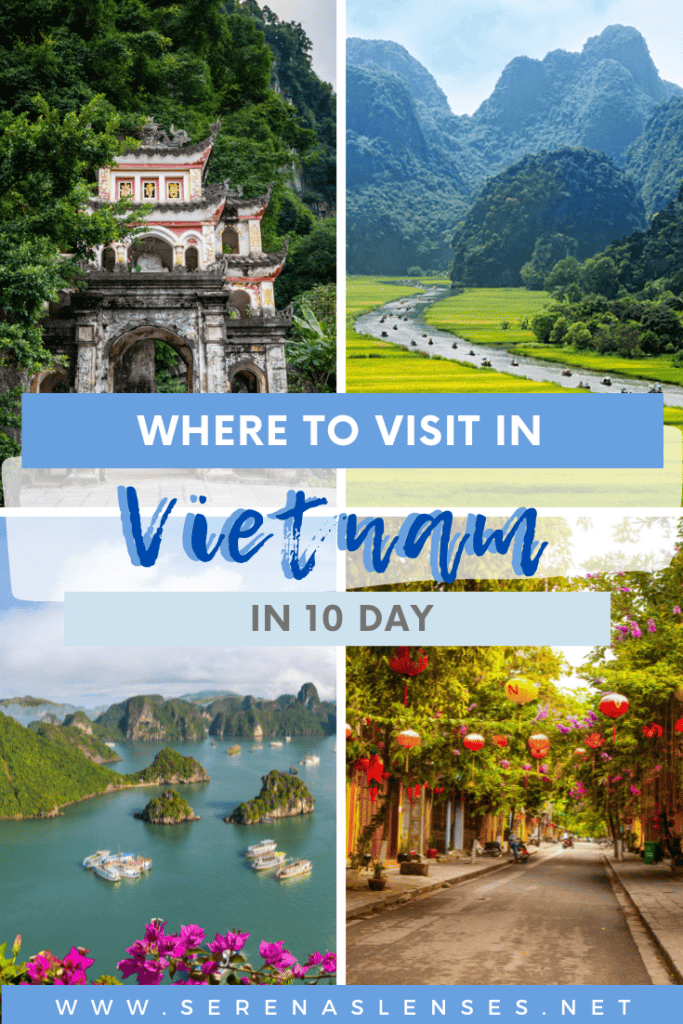10 Days in Vietnam: The Best 10 Day Vietnam Itinerary For First Timers

Have 10 days in Vietnam? Follow this 10 day Vietnam Itinerary to see all the amazing places there especially if this is your first time in Vietnam.
Vietnam is probably one of the most underrated countries in Southeast Asia. While most of the tourists flock to Thailand or Singapore, I loved Vietnam so much that I went back multiple times just to explore different regions of Vietnam.
Vietnam is a country with rich history and culture, incredible food, beautiful beaches, mountains and scenery that will leave you surprised and amazed. It is one of the best places to visit in Southeast Asia and it is probably the No.1 country I would recommend visiting in SE Asia.
There are many ways to spend 10 days or even 2 weeks in Vietnam. This 10 day Vietnam itinerary will focus on how to see the highlights of Vietnam from North to South.
In this 10 day Vietnam itinerary, I will also provide you with useful information to plan your Vietnam holiday, this include:
- Useful things to know before you go to Vietnam
- How to get a Vietnam tourist visa
- When are the best months to visit Vietnam
- How to get a sim card in Vietnam
- Transportation in Vietnam
- Detailed 10 day Vietnam itinerary
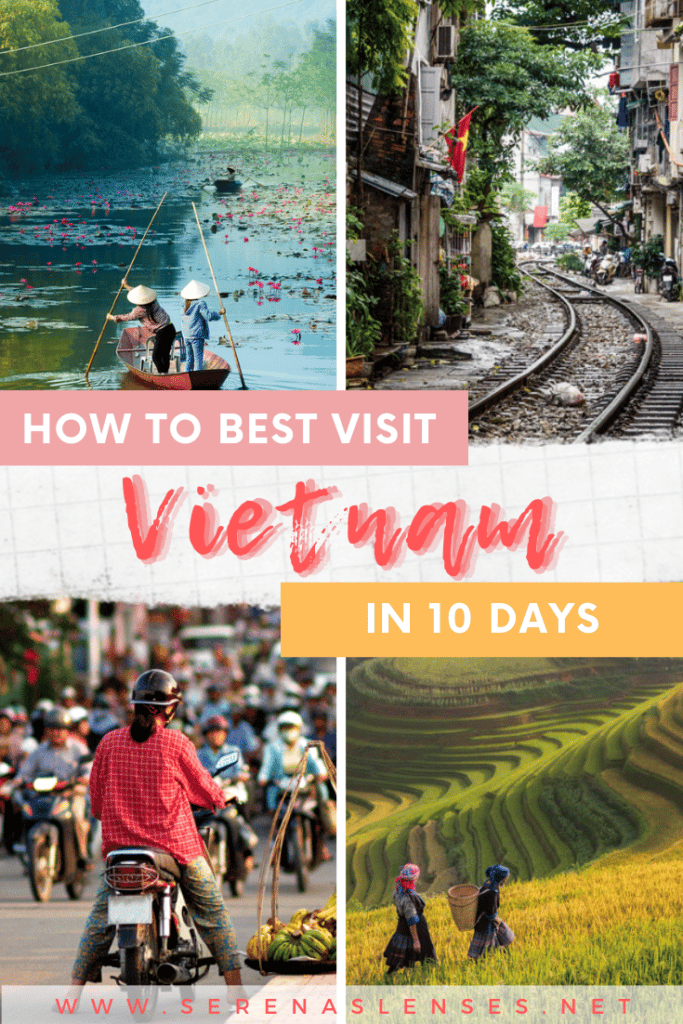
This blog contains occasional affiliate links, where I receive a small commission on sales of the products/hotels that are linked at no additional cost to you. In addition, as an Amazon Associate, I earn from qualifying purchases. Thank you for supporting my blog.
Planning your first trip to Vietnam?
I have written a TON on Vietnam to help you plan your amazing Vietnam trip.
Whether you are planning to spend 10 days or 2 weeks in Vietnam, you will definitely find these articles helpful.
From sleeper trains to Halong Bay cruise to Ba Na Hills to Hue, these articles will for sure make your trip memorable and fun!

Where To Vist in Vietnam
Vietnam has a diverse landscape, spanning from the North to South, including mountains, rivers (and bay), rice terraces, the largest cave in the world, and beaches. Vietnam offers both modern cities and ancient towns, providing you with different experiences and a glance into its history.
Some of the best places to visit in Vietnam include Sapa, Ha Giang, Ba Be National Park, Hanoi, Halong Bay, Hue, Da Nang, Hoi An, Son Dong (the world’s largest cave), My Son (a world cultural heritage site), Ho Chi Minh City and the islands in Southern Vietnam.

If you were like me and only have 10 days in Vietnam, use my itinerary as a guide to plan your trip there! This 10 day Vietnam itinerary will not be able to cover all the places I just mentioned above, and my intention is to give you a flavor (and an example) of how to see the most popular places in Vietnam.
You can always swap our certain things as you plan your own Vietnam trip. Regardless of what you plan to do and see in Vietnam, I am still super jealous of all the great experience and food you will have on your trip.
Things To Know Before Visiting Vietnam For The First Time
- Vietnam Tourist Visa may be required if you are from certain countries (like from the US or Canada). Make sure to check the visa requirement before you go. Some countries do enjoy visa-free entry into Vietnam, including many EU and Asian Countries (excluding China, Taiwan, Hong Kong, etc).
- Currency in Vietnam is Vietnamese Dong and 1 USD is about 23,500 Vietnamese Dong.
- You need to have cash with you in Vietnam; most places do not accept credit card. You should have some USD (or Euros) with you so you can convert in Vietnam (like at hotels and banks) as ATMs are not readily available everywhere.
- Use ATMs if you intend on taking out cash. You get better rates at local ATMs than if you were to exchange money
- Do not drink the tap water in Vietnam and try not to get ice cubes with your drinks; buy water but make sure the bottles are properly sealed
- Download Whatsapp! Businesses are done over Whatsapp (like bus/ train booking, hotel communication etc). It is so much easier to communicate over Whatsapp than email.
- Your hotel can help you book almost everything, such as transportation, tours, attractions, etc.
- A travel adapter/ converter is needed if you are traveling from North America and Europe.
- Use an eSim or get a physical sim for Vietnam if you need internet.
Where to Stay in Vietnam
It is super easy to find cheap (but good) accommodations in Vietnam. In fact we’ve stayed at a wide range of hotels and guest houses in Vietnam, from $30 a day to $200 a day (for two people).
The detailed itinerary below shows you where to stay in Vietnam in each of the cities on this itinerary but here I will give you a short highlight. These are the places I’ve stayed at in Vietnam since I’ve been a couple of times.
- Hanoi: Meritel Hanoi in the center of Old Quarter
- Halong Bay: Stellar of the Sea Cruise
- Ninh Binh: Tam Coc Horizon Bungalow
- Hoi An: Q Villa
- Ho Chi Minh City: The Reverie Saigon
- Phu Quoc: L’Azure Resort and Spa
10 Day Vietnam Itinerary From North to South
Here is an overview of how to spend 10 days in Vietnam, then you will see the detailed day to day itinerary. This itinerary starts from the North in the capital city of Vietnam and moves down south.
Day 1: Hanoi
Day 2: Ninh Binh
Day 3-4: Halong Bay Cruise
Day 5-6: Hoi An in Central Vietnam
Day 7 & 8: Ho Chi Minh City
Day 9 & 10: Phu Quoc Island
Vietnam Itinerary Day 1: Hanoi
Start your 10 day Vietnam journey in Hanoi, the capital city of Vietnam and the largest city in Northern Vietnam. It is a super nice city to visit and a great place to start your 10 days in Vietnam.
If you are flying into Hanoi, here is a guide on Hanoi Airport to Old Quarters to give you some ideas on the best way to go to Old Quarters. For first time visitors, you will most likely be staying in the Old Quarter and do sightseeing around there.

Hanoi is the capital city of Vietnam and it is a cultural mix of Western and Eastern influences. As you wander around Hanoi, you will see there are many well preserved colonial buildings as well as ancient pagodas in Hanoi.
What to see in Hanoi
A few famous places in Hanoi you can check out include
- Hanoi Old Quarter
- Temple of Literature
- Hoan Kiem Lake
- Night markets (beware of pickpockets)
- Ho Chi Minh Mausoleum
- Ho Chi Minh Museum
- Visit pagodas and Cathedrals
- Thong Nhat Park
- Train Street
- Beer Corner
I absolutely loved just walking around the Old Quarter to see what local life is like there. You will find tons of street food vendors, shops and coffee shops. If you see something that looks appealing, be sure to stop and try it!
In particular I enjoyed walking around the Old Quarter at night. On specific nights there will be night markets where you can buy souvenirs, clothes, food, and other small trinkets. You should also stop by the super famous Beer Street if you want to see how lively Old Quarter gets at night! I was walking alone and felt totally safe around 7-9pm!

You can also watch a show at the Opera House, see a water puppet show in Hanoi and shop at the famous Dong Xuan Market.

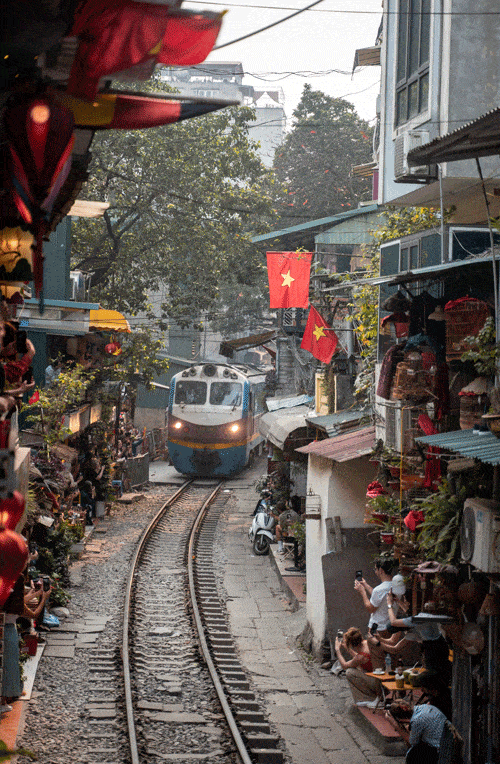
One very famous Instagram worthy thing to do in Hanoi is to visit the Hanoi Train Street, where you can watch an actual train speed by along a cramped street full of cafes and shops (although some cafes may have closed due to government order and the pandemic).
Due to accidents in recent years, train streets do randomly get “closed down” but you can still visit. The most popular stretch of the train street have a lot of cafes and sometimes you will need a cafe owner to bring you in from the “backdoor”.
Other parts of train street without cafes are always open.

Usually the trains come at 3:20pm (weekends only) and 7:30pm (weekday) but the timing is not always accurate. It’s best to go before the scheduled time and just wait around.
Tours You Should Consider in Hanoi
Hanoi has a ton of things to eat and I think you really should take one of the street food tours to explore the best local flavors. I highly recommend this Hanoi street food tour if you are curious about authentic Vietnamese cuisine!
If you are scared of street food don’t worry, you can always do a cooking class. I personally love the cooking class because you really get to learn how to make authentic Vietnamese dish at home.
Where to stay in Hanoi
I stayed at the Meritel Hanoi in the center of Old Quarter. The hotel is super modern with a rooftop pool and they helped us book our day trips to Tam Coc and Ha Long Bay overnight cruise the first time we visited Vietnam.
Another 2 hotels we stayed at in Hanoi during our two visits were Babylon Premium Hotel and La Storia Ruby Hotel. Both were good and La Storia Ruby Hotel was quite cheap and sufficient.

If you want to stay somewhere very luxurious in Hanoi, then I would recommend either the Sofitel Legend Metropole Hanoi or the Movenpick Hotel Hanoi. But personally I think the hotels I mentioned above are already really nice and clean.
Read Next: How to Spend 2 days in Sapa
Vietnam Itinerary Day 2: Tam Coc (Ninh Binh) Day Trip From Hanoi
Take a day trip from Hanoi the next day to Tam Coc, an area in Ninh Binh.
Tam Coc is known as “Halong Bay on land“. It’s an area with rice paddies and Ngo Dong River running through limestone caves and mountains. It’s located 90 km from Hanoi but it’s way less crowded than Hanoi or Halong Bay.
You can take a full day tour to Tam Coc and different tours do offer different options.
- Tour Option 1: Goes to Hoa Lu Ancient Capital, Mua Cave (beautiful view of the area), Tam Coc boat ride on Ngo Dong River and Bich Dong Pagoda.
- Tour Option 2: Includes Bai Dinh Pagoda, Mua Cave and a 3 hour Trang An Boat ride (which is different than the 2 hour Tam Coc Boat ride above).


Click here for the dress
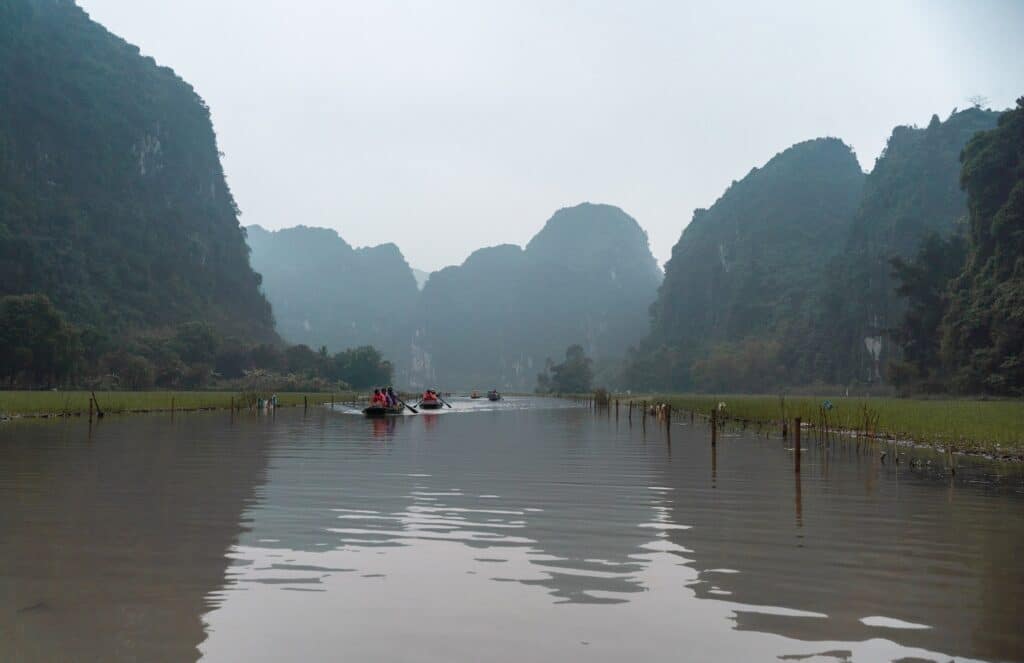
With the first tour, you can do the boat ride on the Ngo Dong River, where the rowers are local ladies who use their feet to row the boat. They are so good at it that it feels like they’ve been doing it forever. I suppose it’s just a lot easier to row with your legs/feet instead of arms.
This 3 hour Trang An Boat Ride with the second tour has 3 different routes and you get to pick the route and get off the boat at each stop along the boat ride. I really liked the Trang An boat ride (more than the Tam Coc one actually).

Click here for dress

The whole area of Tam Coc looked like it’s straight out of a painting. I actually think the scenery in Ninh Binh (Tam Coc) is the most beautiful during our 10 days in Vietnam trip.
If you do not want to join a tour, you can definitely visit Ninh Binh by yourself from Hanoi. You can rent a scooter (or hire a private taxi) once you are in Tam Coc to explore all the spots.
You can take buses or trains (or even private transfer) from Hanoi by booking them on this website. This would give you more flexibility especially if you plan to stay overnight or spend more time at a particular spot.
Day 3 & 4 in Vietnam: Halong Bay Overnight Boat Cruise
Halong Day is famous for its thousands of limestone islands in the emerald water. It is located in Northern Vietnam about 3-4 hours from Hanoi. Most people take an overnight boat tour on Ha Long Bay because it’s simply too far from Hanoi to do a day trip.
I have been to Halong Bay twice and had a good time both times.
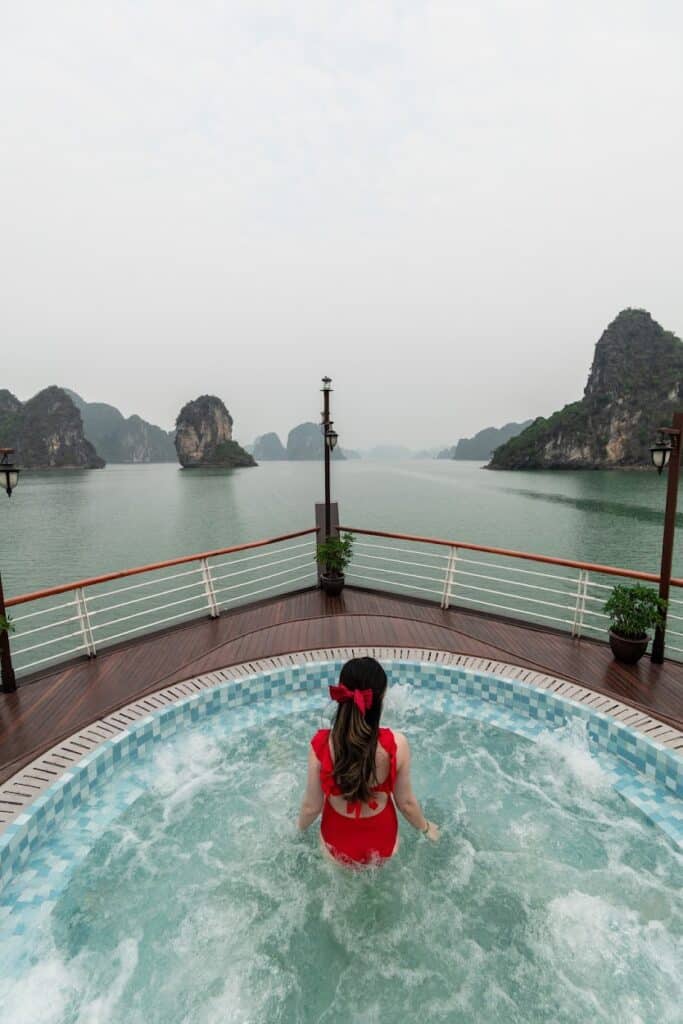
Looking for this swimsuit? You can purchase it here.
Different cruise companies offer different types of activities and amenities. Some of the cruise companies go to Lan Ha Bay and the itinerary includes exploring caves at Cat Ba Island, swimming and morning kayaking.
Some other cruise companies go to Halong Bay and they would go to floating villages and hiking up Titop Island for a panoramic view of Halong Bay.

While onboard, Halong Bay cruises generally have Tai-chi class, cooking class, lounge chairs, deck, Happy Hour (you need to pay for the drinks), common area with TV and DVDs, evening squid fishing, etc.

Having done the Halong Bay cruise twice, I really do feel the cruise was the most relaxing part of our entire 10 day Vietnam itinerary (and yes I did two 10 day trips in Vietnam and both were intense!).

Everything was arranged and you just relax on one of the most beautiful bodies of water in the world. You also get to try some Vietnamese wine and beer on the boat with this view, so what more could you need?
In recent years many newer cruises offer a route to Lan Ha Bay (a part of Halong Bay that is not as touristy). If you want a more laidback and relaxing trip to Halong Bay you can consider cruises offering routes to Lan Ha Bay.

Some of the most luxurious Halong Bay cruises now include Emperor Cruise, Orchid Cruise, Stellar of the Seas Cruise, Heritage Cruise, etc. These are the instagram worthy cruises that you often see on social media with the pool on deck and floor to ceiling glass bathrooms.
To learn more about Halong Bay, see my complete Halong Bay Cruise guide.
Vietnam Itinerary Day 5 & 6: Hoi An Ancient Town (Or Optional Day Trip to the Golden Bridge aka the Hand Bridge)
After spending a few lovely days in Northern Vietnam it was time to start traveling south to the middle of Vietnam. Hoi An is an ancient town located in the middle of Vietnam (near the water on the eastern side of the country).

Hoi An is one of the most well known towns in Vietnam due to its well preserved historical center and the colorful lanterns and buildings. It used to be a major trading port from the 15th to 19th century. Since it is an UNESCO World Heritage Site, you will get to experience how life looked like back in the days.
How to Hoi An From Hanoi
To travel from Hanoi to Hoi An, the fastest way is to fly. There are trains and buses to Hoi An but they take much longer although if you are planning to do an overnight bus or train these are good choices.
Hoi An does not have an airport of its own, so travelers need to fly from Hanoi to Danang (which is also a cool place to visit, it has a beach!). There are over 20 flights from Hanoi to Da Nang everyday and it’s a short flight about 1.5 hours.
Once you land in Da Nang, look for the bus station to Hoi An. Alternatively you can take a taxi or have your hotel pick you up. Our hotel offered to pick us up at 315.000vnd/car, which is about 15 USD.
Things to See in Hoi An
The most famous site in Hoi An is the Japanese Covered Bridge, it’s a historical piece of Japanese architecture . If you want to walk through the bridge then you have to pay an entrance fee, so most visitors actually opt to just take a photo in front of the Japanese Covered Bridge.

Assembly Hall of the Fujian Chinese Congregation is a temple for the worship of Thien Hau, a deity from China. I visited during the Chinese new year so it was very festive inside the Assembly Hall.

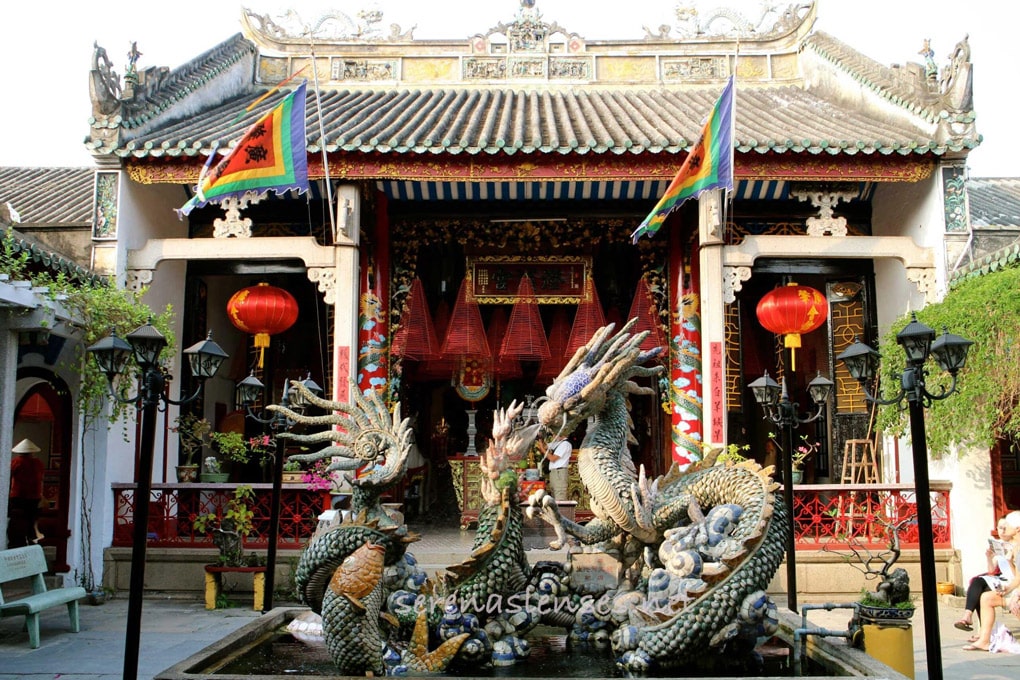
Other things you should do in Hoi An include walk through the ancient town, find the lantern shops, eat from street vendors, visit the local markets, rent a bike to bike around, enjoy the night scene and light a lantern and put them in the river.
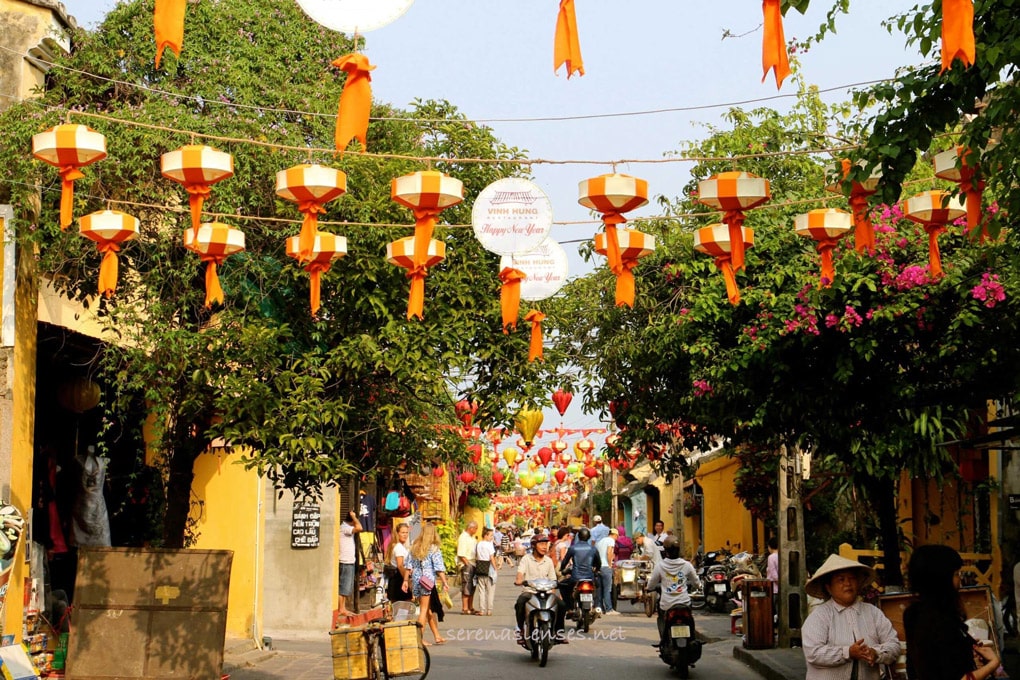
Read Next: How to spend one day in Hoi An – what to do and eat in Hoi An
Golden Bridge (Hand Bridge) in Ba Na Hills (Optional Day Trip)
In June 2018, Vietnam opened an incredibly cool looking bridge called the Golden Bridge near the city of Da Nang in Ba Na Hills Resort. Photos on social media immediately attracted tons of tourist and many visitors are going to Vietnam just for the Golden Bridge or the Hand Bridge.
Golden Bridge is located in a theme park called Sun World Ba Na Hills and can only be visited by riding a cable car up in the Ba Na Hills Resort. The bridge is 1500m above sea level and it’s about 500ft long.
Fortunately for those of you visiting Hoi An, you can take a taxi from Hoi An to Ba Na hills in about 1-1.5 hours to visit the Golden Bridge.
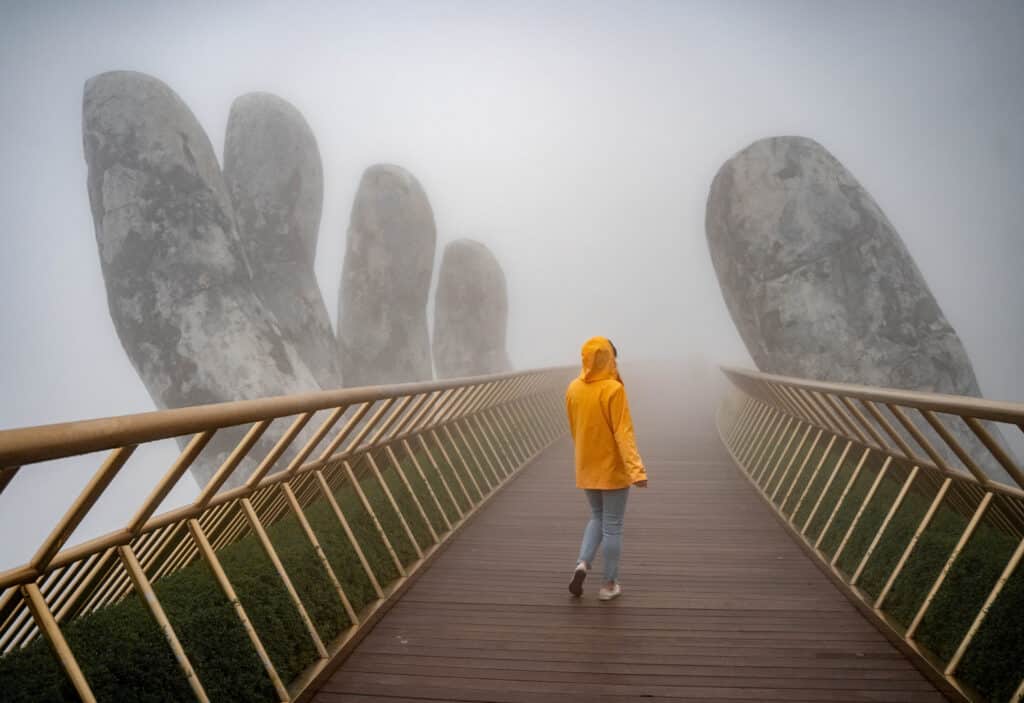
After you visit the Golden Bridge, you should also explore other attractions at Ba Na Hills such as the French Village, Le Jardin D’Amour, Linh Ung Pagoda, etc.

You can check out my Golden Hand Bridge guide to get more details.
If you have some extra time in Vietnam, be sure to check out this 3 day Danang itinerary which also includes how to visit the Golden Bridge.
Where to Stay in Hoi An
For beach lovers, you would love the luxury Palm Garden Beach Resort & Spa or the Dai An Phu Villa. You can walk to the beach in under 5 minutes and there is a free shuttle service to Hoi An Ancient Town. There are spas and massages at the hotel for a truly luxurious experience.
For those who want to stay in a medium ranged hotel closer to the Hoi An ancient town, I would recommend either the Silk Luxury Hotel & Spa or Vinh Hung Heritage hotel.
If you are a budget traveler, there are nice hotels/ hostels that cost less than 30 USD a night that’s close to the center of Hoi An historical town such as Hoi An Ivy Hotel or Q Villa. We stayed at Q Villa and loved it.
Day 7 & 8: Ho Chi Minh City
Ho Chi Minh City is the largest city in Vietnam by population. It’s located in the Southern part of Vietnam and has a tropical (wet and dry season) climate.
Ho Chi Minh City played an important role during the Vietnam War (anti-communist). Before that it was ruled by the Japanese and French, so that’s why most of the architectures you see in Ho Chi Mihn City are of French influence.
You can fly to Ho Chi Minh directly on Jetstar from Da Nang.
What to do in Ho Chi Minh City: some of the things you can do in Saigon include the
- Cu Chi Tunnels (underground tunnels used during the Vietnam War)
- Binh Tay Market and Ben Thanh Market
- Independence Palace
- War Remnants Museum
- Cao Dai Temple
- Jade emperor Pagoda
- Saigon Notre-Dame Basilica
- bar hopping at Pham Ngu Lau Street
- Visit a rooftop bar
If you have time, you can also do some excursions outside of the city, such as a visit to the Mekong Delta, the Cai Be Floating Market, etc.
Where to Stay in Ho Chi Minh: if you are looking to stay at a hostel, check out this post on hostels in Ho Chi Minh.
If you prefer a more luxurious experience, then I would highly recommend either The Reverie Saigon, Silverland Yen Hotel, or the Alagon D’antique Hotel & Spa.
Day 9 & 10: Beach At Phú Quốc
After the hustling and bustling of Saigon, it’s time to relax on the beach! Most people don’t realize that Vietnam has nice beaches (at least I didn’t know) but I was pleasantly surprised by the island of Phu Quoc.
Phu Quoc Island is located off the coast of Cambodia and is known for its white sand beaches and resorts. It’s a hidden gem because most tourists go to islands in Thailand so Phu Quoc is not nearly as crowded as Thailand.
Even though it was February but since the island is so south that it was actually a nice beach weather. There is a direct flight from Ho Chi Minh City to Phu Quoc so it was perfect for our itinerary.
Where to stay in Phu Quoc: there are a lot of wonderful hotels in Phu Quoc by the beach, such as the Seashells Phu Quoc Hotel & Spa, L’Azure Resort and Spa, Movenpick Villas & Residences, Dusit Princess Moonrise Beach Resort, etc. These 5 star hotels are no more than $150 a night which is crazy to me since they would cost over $1000 a night in Hawaii or something!
What to do in Phu Quoc: BEACH!! There are many nice beaches in Phu Quoc such as Truong Beach, Vung Bau Beach, and Sao Beach. The most famous one would be the Sao beach.


If you are a fan of kayaking then this kayaking and starfish tour would be perfect for you.
Snorkeling and scuba diving are also popular activities on Phu Quoc since the water is warm and calm.

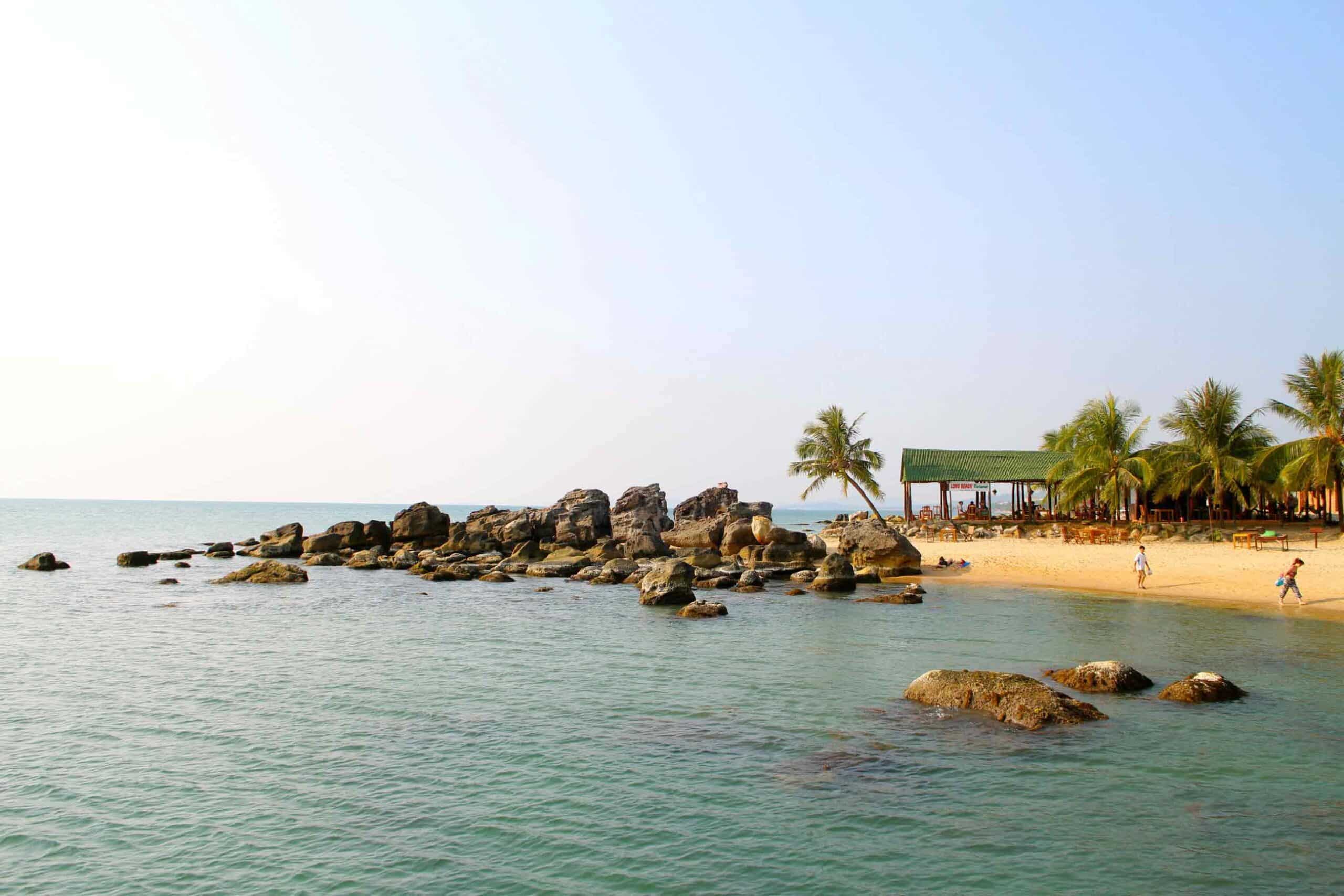
Besides beach, you can also take the famous Phu Quoc cable car from Phu Quoc to Hon Thom Island. It takes about 15 minutes each way and it is a breathtaking experience. You get amazing views of the sea and islands on a clear day and it is the longest non-stop 3 way cable car in the world.
Vietnam Tourist Visa
There are a number of Vietnam visa-exemption countries where citizens can enter Vietnam for 14 – 30 days without a visa. These countries include most of Southeast Asian countries, Nordic countries and some other European countries. See the list of exemption countries here.
If you need a visa to enter Vietnam (if you are from the US, Canada, India, China, UAE, etc), see the options below
Getting Visas from Local Vietnam Embassies (in person, by mail, online)
If you have a lot of free time or simply like to have everything done and ready for your Vietnam travels, you can apply for visa ahead of time from a local embassy in your country.
I had done this in Hong Kong (where I physically went to the embassy) to get my Vietnam Visa.
You can also apply to Vietnam visa by mail or online. If you live in the US, this is a good resource to use when applying for Vietnam visa.
Vietnam E-Visa
<Updated September 2023: Vietnam now offers 90 day multi-entry visa for tourists starting August 15th>
You can apply for an electronic visa (e-Visa) to obtain a 90 day single or multi entry Vietnam visa for your trip. Not every country is allowed for E-visa issuing and there are specific airports and land ports that accept Vietnam E-visa.
You can also apply for the Vietnam E-Visa online yourself on the official government website. It takes no more than 10 minutes and only costs USD 25. Follow my step by step instruction on how to apply for a Vietnam e-Visa.
Vietnam Visa on Arrival (VOA)
Visa on Arrival is an option for visitors of certain countries to obtain a Vietnam Visa when they land in designated international airports in Vietnam including Hanoi, Hai Phong, Da Nang, Nha Trang and Ho Chi Minh City.
If you are a citizen of these countries, you are eligible for Vietnam visa on arrival.
You will need to get an approval letter in advance before you land at the designated airports mentioned above in order to obtain the visa.
You will also need 2 passport sized photos, your passport, $75 USD in cash. For more information on how to get Vietnam visa on arrival, check out this useful website.
It is much cheaper to apply for Vietnam e-Visa online, since it only costs USD 25.
Best time (and worst time) to visit Vietnam
The best time to visit Vietnam would be December to April, avoiding the rainy season. But there are certain exceptions.
If you are planning to visit mountainous regions like Ba Na Hills or Sa Pa, it’s better to visit during late spring and summer time. Otherwise you risk seeing just fog during the winter and early spring times.
Geographically, Vietnam is very “long”, with different parts of Vietnam having vastly different climates. Vietnam also has a rainy/monsoon season that can bring large amounts of rainfall and even flooding in September and October.
I will break down the yearly weather in Vietnam into 3 portions: North, Central, and South.
Northern Vietnam Weather

Northern Vietnam is the north side of the country, sharing its border with China in the North and Laos in the west. Sapa, Hanoi and Ha-Long Bay are considered Northern Vietnam.
Northern Vietnam generally enjoys cooler weather between November to March, which is also when it has the lowest level of rain fall. However, if you are in mountainous regions, the whether during November to March can be quite foggy and cold but relatively dry.
Read Next: Best things to do in Sapa in 2 days
Central Vietnam Weather
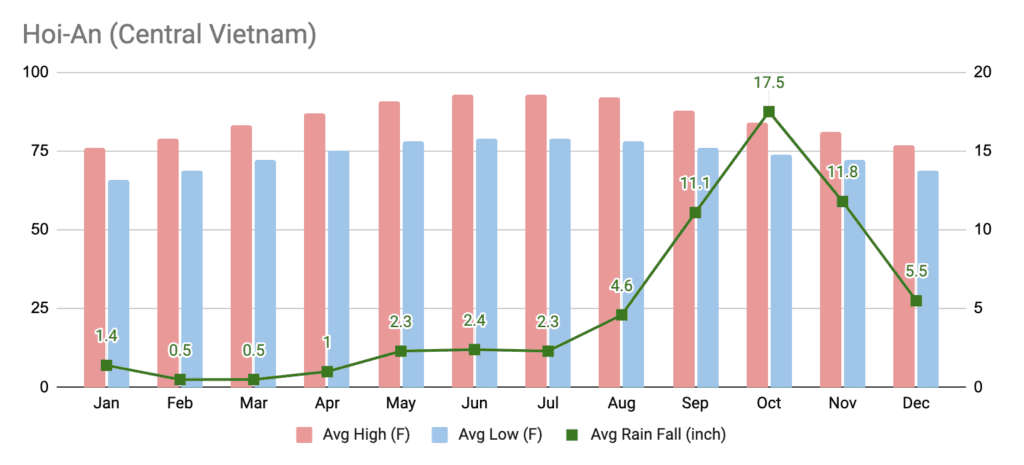
Central Vietnam enjoys tropical climate, and it is the “thinnest” part of the country. Central Vietnam enjoys pretty hot weather almost year round. The most famous places in Central Vietnam includes Hue, Da Nang and Hoi An.
Between September and November is when Central Vietnam gets the most amount of rain and there is a high chance of flooding. I would not recommend visiting Central Vietnam during those rainy months.
I visited Central Vietnam twice in February and both times had pretty good weather (the second time it was a little rainy but not bad).
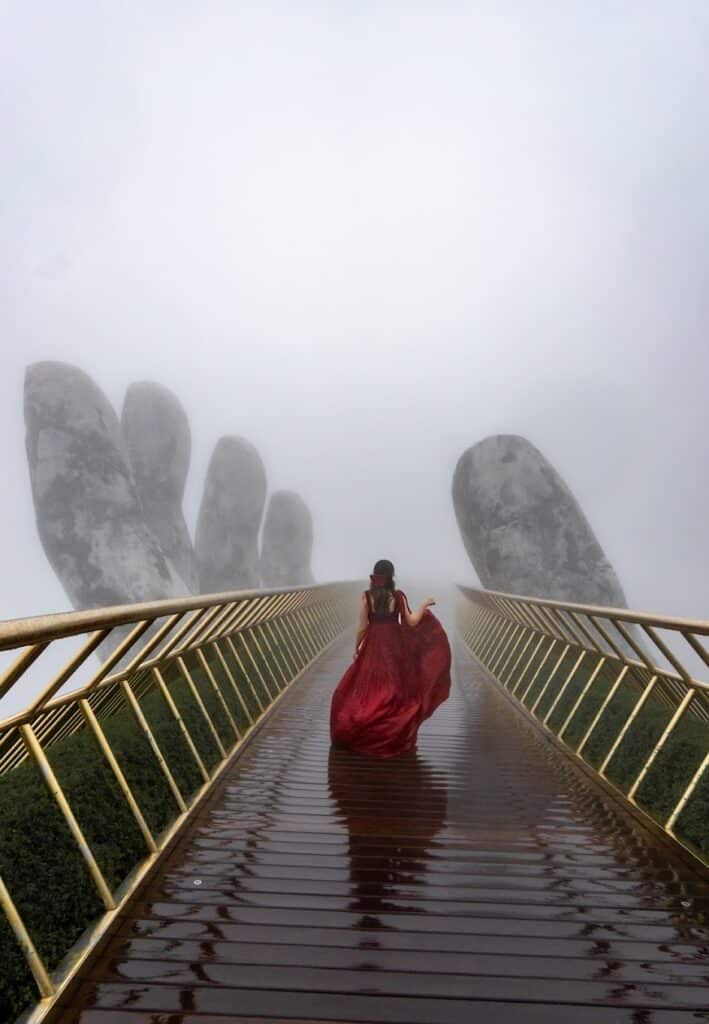
The only exception was Ba Na Hills, where it was rainy and foggy almost everyday from December to end of February. So if you want to visit Ba Na hills to see the Golden Hand Bridge, it’s better to visit from March to July even though it will be hot in the summer but you are more likely to get a clear day.
Southern Vietnam Weather

Southern Vietnam is most famous for Ho Chi Minh City as well as the island of Phu Quoc, off the coast of Cambodia. Southern Vietnam enjoys a relatively consistent warm weather all year round, with the highest level of rainfall from May to October.
The islands in Vietnam will be warm enough even in the “winter” months, but with the most clear skies in February.
Is Vietnam safe?
Vietnam is a pretty safe country for tourists, even for female solo travelers.
However, like any Southeast Asia country, there is petty crime such as pick pocketing. Be sure to watch your bags/wallets closely, especially in crowded areas (and if you do not look Asian).
I have heard stories from friends that their purses were slashed from behind when they were shopping at street markets in Hanoi.
If you have jewelry you may want to leave them at home. It is not prudent to flaunt your wealth with big bling blings in Vietnam. You may not get robbed but it’s frowned upon.
For those who are not familiar with the traffic conditions in Vietnam, you will need to watch out for cars and motorbikes. Motorbikes are the main transportation in Vietnam and in cities like Hanoi, it can get quite overwhelming.
Even though the drivers will try to avoid you (they are very good at that!), but still use caution when crossing the streets. Try to follow locals when crossing the street in Vietnam.

If you are thinking about taking overnight trains or buses, then the good news is that these types of public transportation is safe for solo travelers.
I took both overnight trains and buses, and they felt perfectly safe.
What to eat in Vietnam?

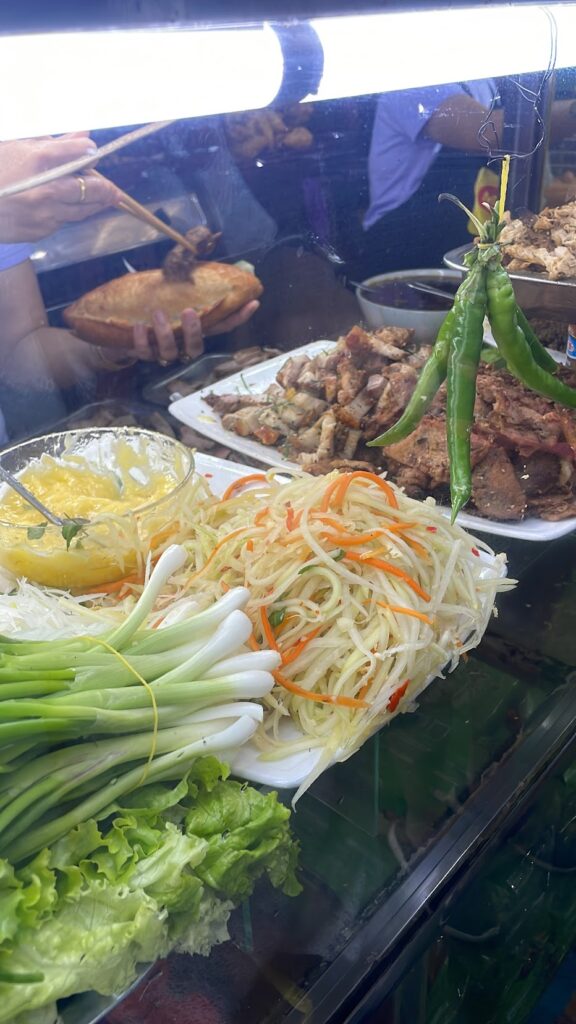
Different regions in Vietnam also have different speciality food. You will need to do some research to figure out what are the best local specialities are in each region. But in general, here are what some of the typical dishes are in Vietnam.
- Pho: The famous Vietnamese noodle soup made with beef or chicken broth, rice noodles, and a variety of fresh herbs and condiments. It is one of the best things you can eat in Northern Vietnam (at least I find the ones in Northern Vietnam tastier)
- Bánh Mì: World renowned Vietnamese sandwiches, which are typically filled with a combination of grilled meats, vegetables, pâté, and fresh herbs, served in a baguette. I had the best Banh Mi in Hoi An!
- Gỏi Cuốn: Fresh spring rolls filled with shrimp, herbs, pork, rice vermicelli, and other ingredients, often served with a peanut dipping sauce.
- Bún Chả: Grilled pork patties and sliced pork belly served over vermicelli noodles, often accompanied by fresh herbs, peanuts, and a dipping sauce. There are some really good places for this in Hanoi Old Quarter.
- Cơm Tấm: Broken rice served with grilled pork, fried egg, and fish sauce, often garnished with pickled vegetables.
- Bánh Xèo: Vietnamese sizzling pancakes filled with shrimp, pork, bean sprouts, and herbs, typically served with a dipping sauce. You can find some of these really good ones in Hue
- Bún Bò Huế: A spicy beef noodle soup originating from the city of Hue, featuring tender slices of beef and pork, lemongrass, and chili
- Cá Kho Tộ: A popular Vietnamese braised fish dish, often cooked in a caramelized sauce with black pepper and served with rice
- Bánh Cuốn: Steamed rice rolls filled with ground pork, mushrooms, and other ingredients, often served with fried shallots and fish sauce
- Chả Giò: Fried spring rolls, often filled with ground meat, shrimp, and vegetables, wrapped in rice paper
- Hủ tiếu: A noodle soup dish with a clear and flavorful broth, typically containing seafood, pork, and rice noodles
- Bún Riêu Cua: A crab noodle soup with a tomato-based broth, often served with a crab and shrimp paste mixture.
- Bánh Canh: A thick Vietnamese noodle soup made with wide, udon-like noodles and a variety of toppings, including seafood, meat, or vegetables.
- Bánh Tráng Nướng: Grilled rice paper topped with various ingredients such as egg, cheese, and meat, then rolled and sliced.
- Hấp Hủ tiếu Nam Vang: A dish featuring clear rice noodles topped with a mixture of shrimp, squid, pork, and a special savory sauce.
- Bánh Khoai: A Vietnamese crepe or pancake often filled with shrimp, pork, and bean sprouts.
- Mì Quảng: A noodle dish from central Vietnam featuring turmeric-seasoned noodles, a variety of meats, and herbs, served with a small amount of flavorful broth.
- Gỏi Khô Bò: A beef jerky salad made with thinly sliced dried beef, often served with peanuts and herbs.
- Bún Riêu Cua Ốc: A combination of crab and snail soup, typically served with rice vermicelli noodles.


There are also a ton of popular Vietnamese desserts that you should try, and here are some of the famous ones:
- Vietnamese coffee: You absolutely cannot leave Vietnam without trying their coffee, especially the famed Egg Coffee and Coconut Coffee!
- Chè: Chè is a broad category of Vietnamese sweet soups or puddings made with a variety of ingredients. These can include mung beans, black-eyed peas, sweet potatoes, lotus seeds, tapioca pearls, and fruits.
- Bánh Bò: Bánh bò, also known as Vietnamese honeycomb cake, is a spongy, steamed cake made from rice flour, tapioca starch, sugar, and coconut milk. It has a unique honeycomb-like texture.
- Bánh Chuối Hấp: This is a steamed banana cake, typically made with ripe bananas, rice flour, sugar, and coconut milk. It’s a moist and fragrant dessert.
- Bánh Flan: Bánh flan is the Vietnamese version of crème caramel or flan. It consists of a layer of caramelized sugar topped with a creamy, egg-based custard.
- Bánh Tiêu: Bánh tiêu are Vietnamese hollow doughnuts that are deep-fried until they puff up and turn golden brown. They are often filled with sweet mung bean paste or custard.
- Chuối Nếp Nướng: Grilled sticky rice and bananas are a delightful dessert often found in Vietnam. The combination of grilled sticky rice and caramelized bananas creates a sweet and slightly smoky flavor.
- Kem Xôi: This dessert combines two popular Vietnamese items, kem (ice cream) and xôi (sticky rice). The sticky rice is often dyed with natural colors and served with a scoop of ice cream.
- Bánh Pía: Bánh pía is a type of Vietnamese pastry, often filled with mung bean paste, taro, or durian. It has a flaky crust and is a favorite gift or souvenir.
- Xôi Gấc: Xôi gấc is a red sticky rice dish made with gấc fruit, which is known for its bright red color. It’s often served during festive occasions.
To find good restaurants to eat in Vietnam, I would recommend that you use Google Maps and TripAdvisor! We used both and found the reviews spot on!
How to get around Vietnam
It is pretty easy to get around Vietnam, and some of the most popular methods to get around Vietnam include:
- Renting a Moped or motorbike
- Local Bus
- Luxury shared van
- Sleeper bus or sleeper train
- Flying on Vietnamese Airlines, Bamboo Airways or VietJet
- Calling taxis with Grab App (works like Uber)
Travel by Moped or Motorbike in Vietnam
If you are comfortable driving a moped then it is a great and convenient way to get around Vietnam.
Motorbikes up to 50 cc can be ridden in Vietnam without a license, but this may not be the best option for long distance. If you are thinking about simply riding around a city, then this is the perfect option.
If you do have a license plus an International Driver’s Permit, you can rent more powerful motorbikes in Vietnam and ride on some scenic roads in Vietnam including the famous Ha Giang Loop.
If you are planning to ride a motorbike in Vietnam, be sure to protect yourself by getting travel insurance!
World Nomads provides travel insurance for travellers in over 100 countries. As an affiliate, we receive a fee when you get a quote from World Nomads using this link. We do not represent World Nomads. This is information only and not a recommendation to buy travel insurance.
Get around Vietnam by Bikes
If you are traveling in a small area then renting a bicycle from your hotel or hostel is the perfect way to get around.
Travel in Vietnam by Bus
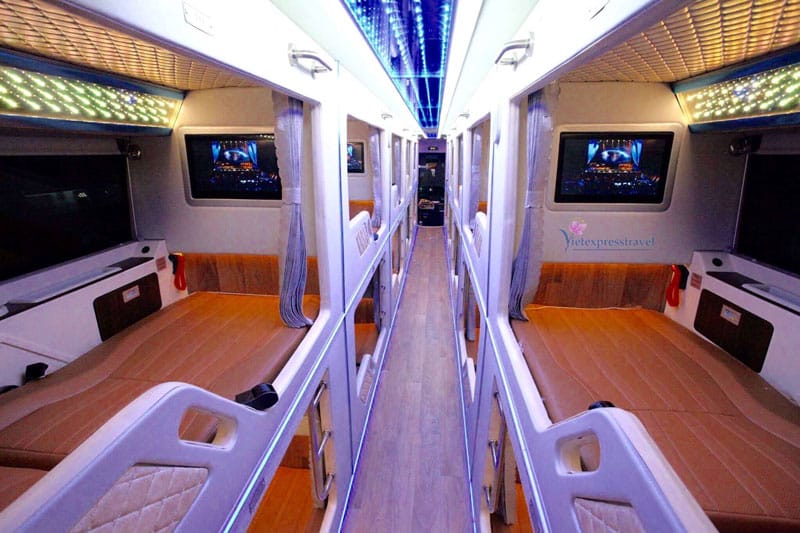
Locals in Vietnam often travel by bus and overnight buses, and there are some pretty luxury overnight sleeper buses there.
These buses have fully reclining flatbeds, fleecy blankets, phone charging stations, etc. You can find the best deals on sleeper buses on this website, which also gives you reviews so you can choose the best one.
I took a luxury sleeper bus from Sapa to Hanoi (although I did it during the day) and had pretty good experience!
Get around Vietnam by Train
Another convenient way to travel within Vietnam is by train, especially luxury overnight sleeper train. A lot of areas within Vietnam are quite far from each other and to best utilize your time (while saving money on hotels), overnight train is the best option.
The most luxury sleeper train have 4 beds (2 bunk beds) in a room. It is perfect for a party of 3 or 4 people so you can book up the entire cabin.
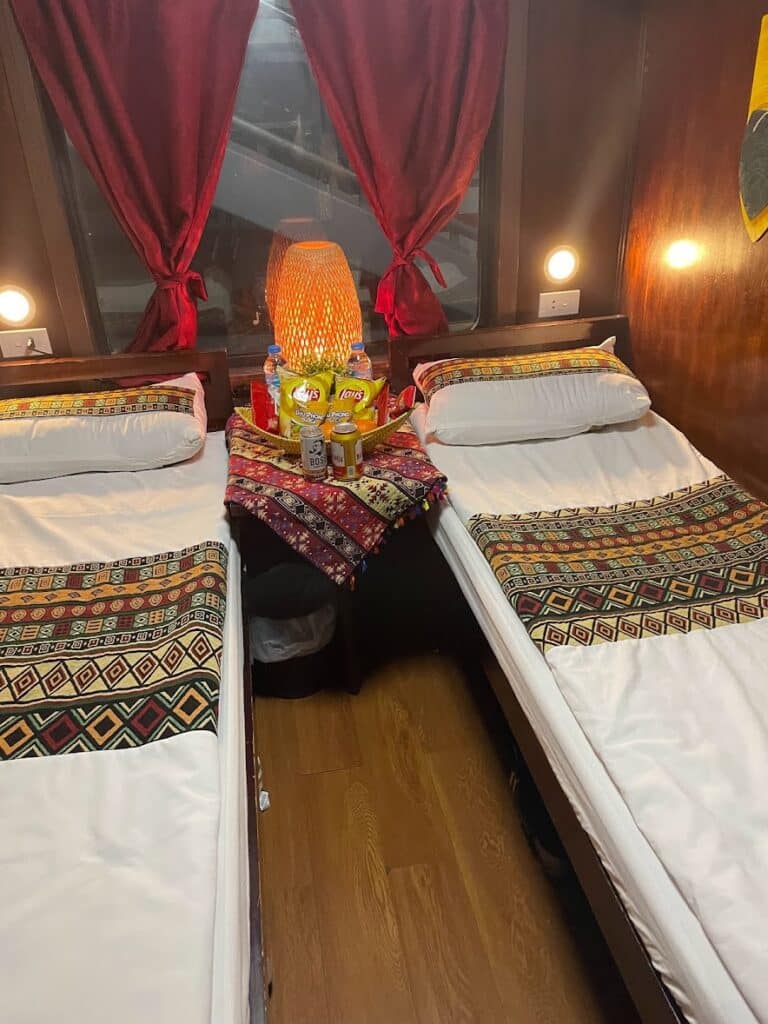
Some trains also have 2 person VIP room with beds. You can also find reviews and book train tickets on this website.
I took the overnight train in a 2 person VIP room from Hanoi to Sapa and had a good (and interesting) experience.
While the room was small, it was cozy and clean, but the train was swinging like crazy and all my things fell from the table during the night. However despite the crazy movement I still had a decent night of sleep (just remember to bring earplugs with you).
Read about my experience taking an overnight train in Vietnam.
Travel in Vietnam by Air
It is pretty cheap to fly within Vietnam, especially since locals tend to take buses and trains more than planes.
You can find a flight from Da Nang to Hanoi for $40 for example.
I did read that it’s better to book Vietnam Airlines instead of the budget airlines such as VietJet Air. My friend who went recently said their VietJet flight from Cambodia was 3 hours EARLY than scheduled time.
I have flown twice in Vietnam and both times had good experience and no delays.
Get around Vietnam by Private Transfer or Taxi
Lastly the most expensive but convenient way to travel around Vietnam is by taxi or private transfer.
If you are thinking about taking taxi in Vietnam, download Grab app. It works pretty much like Uber.
You can also book private transfers on here or ask your hotel to book for you.
Vaccines You Need for Vietnam Travel
Generally you don’t need super specific vaccines for Vietnam and it is very similar to traveling to the rest of South East Asia, but if you want to be extra careful, here are some of the vaccines recommended by the WHO and CDC for traveling to Vietnam:
- Hepatitis A
- Hepatitis B
- Typhoid
- Japanese Encephalitis (very expensive vaccine. I read you don’t really need it unless you plan to move to a rural area for a long period of time. We never got this)
- Rabies
- Meningitis
- Polio
- Measles
- MMR
- Tdap
- Chickenpox
- Shingles
- Pneumonia
- Flu
Most of these vaccines should be routine anyway and you should already have them. For more information on health information while traveling to Vietnam, visit the official CDC website here.
How to get a SIM card and internet in Vietnam
I highly recommend that you get a SIM card when traveling in Vietnam. You can also purchase a Vietnam SIM card at the airport when you first arrive.
The most popular tourist SIM cards are offered by Viettel, Mobiphone, Vietnamobile and VinaPhone. I’ve seen a lot of people using Viettel so you can definitely consider that. You can ask for a 1 month tourist sim which costs about 10 – 20 USD (price and package may change since things change fast there).
If you want the convenience of just having your internet work right after you land, you can consider getting a Vietnam eSim with GIGAGO (running on the Vinaphone network) before you fly.
They provide a wide range of data plans and the most popular plan is 120GB for 30 days (max 4 GB per day) including free first 20 minutes of every call to Vinaphone numbers. I activated the eSim to one of my phones before I flew and internet worked immediately when I landed in Vietnam, so it was super convenient.
If you have T Mobile Magenta Plans (or Magenta Max Plans), you can enjoy free internet roaming. Magenta Max plans give you 5GB of high speed internet (then after that it’s 256kps speed) and Magenta plans give you 256kps speed internet.
Concluding 10 Days in Vietnam
There are a lot of things you can do in Vietnam. 10 days in Vietnam simply is not enough to see everything, but if that’s all the time you have, then you get to see most of what Vietnam has to offer.
If you are short on time, I actually advise you to skip Ho Chi Minh City because it’s not as unique as the other places you get to visit in Vietnam.
If you have more time in Vietnam, I would suggest you spend some time in Sapa or Ha Giang in Northern Vietnam to see all the rice terraces, Cao Bang near the Chinese border for waterfalls and spend some time in Hue, an ancient Vietnam capital in Central Vietnam.
You can read my 2 Day Hue itinerary to get an idea of what to do and eat in Hue.

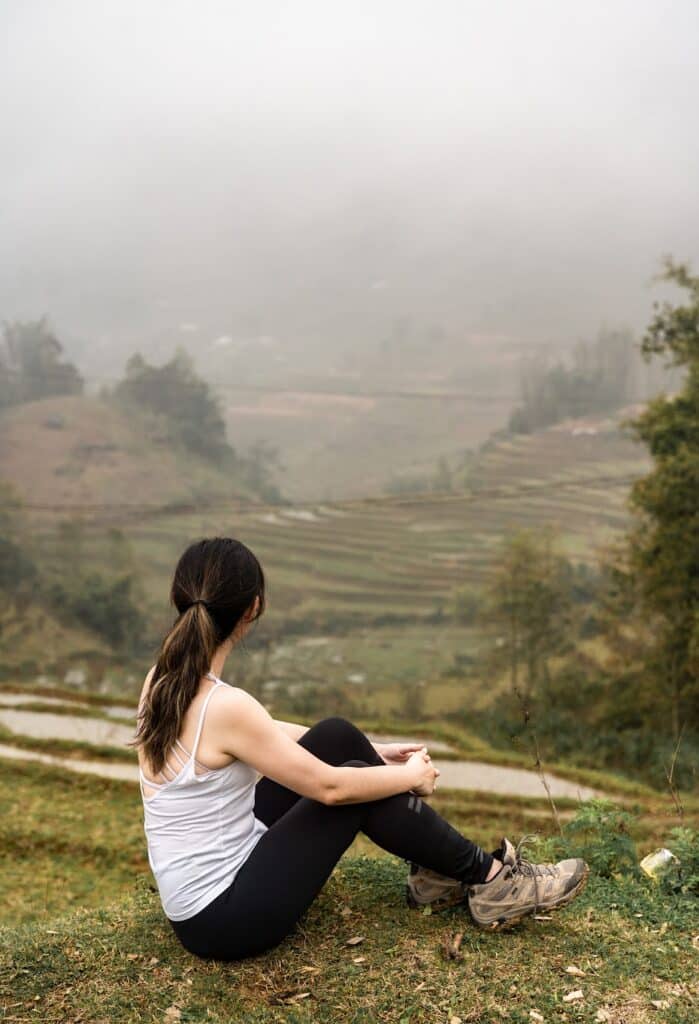
If you are not constrained by budget or time, I highly recommend visiting the Hang Son Doong Cave in Vietnam. Hang Son Doong Cave is the largest cave in the world and it is 3 million years old. Usually you need 4 days to visit the cave and it costs at least USD 3000.
Can’t afford Hang Soon Doong cave? No problem. You can also spend a night camping inside Hang En Cave, one of the largest caves in the world and located very close to Hang son Doong cave in Central Vietnam.
But it is a once in a life time opportunity not to be missed. Regardless what you decide to do in Vietnam or how long you will be visiting, Vietnam will amaze you in every way!
Booking Resources for Vietnam
If you found this article useful, please consider using the links below to book your hotels and tours. We earn a fee from referring you at no cost to you. With your support we can continue to provide useful information for travelers like you to plan that perfect trip to Vietnam.
- Hotel booking sites for Vietnam: this or this
- Tours booking sites for Vietnam: this or this
- Travel insurance
- Train and bus booking site
Other Vietnam Travel Resources
Be sure to check out my other Vietnam travel resources to help plan your trip!
- How to get a Vietnam E-Visa
- 1 Day Hoi An itinerary and Travel Guide
- 2 Day Hue Itinerary to see the best Hue Tourist Attractions
- Best things to do in Sapa in 2 days
- Complete Halong Bay Cruise Guide
- What to do and see in Cat Cat Village in Sapa
- Visiting Golden Hand Bridge in Ba Na Hills
- Vietnam Sleeper Train Guide
- 3 Week Vietnam and Thailand Itinerary
- 2 Week Southeast Asia Itinerary (4 Alternative Itineraries)
Like this post? Pin this 10 day Vietnam itinerary to Pinterest!

